The Shutter Sensors Market is estimated to be valued at USD 3.1 billion in 2025 and is projected to reach USD 6.8 billion by 2035, registering a compound annual growth rate (CAGR) of 8.2% over the forecast period.
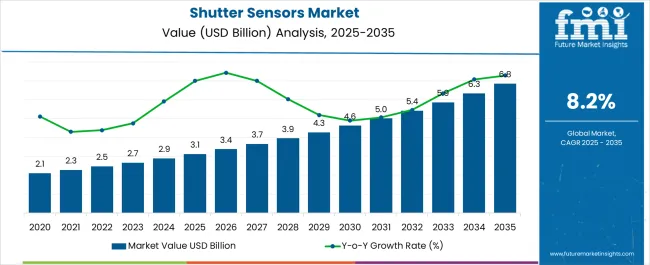
| Metric | Value |
|---|---|
| Shutter Sensors Market Estimated Value in (2025 E) | USD 3.1 billion |
| Shutter Sensors Market Forecast Value in (2035 F) | USD 6.8 billion |
| Forecast CAGR (2025 to 2035) | 8.2% |
The Shutter Sensors market is witnessing strong growth, driven by increasing demand for precision sensing in industrial automation, robotics, automotive systems, and consumer electronics. The adoption of high-performance shutter sensors is being supported by advancements in materials, miniaturization, and sensor technology, enabling higher accuracy, faster response times, and improved durability. Integration with IoT and smart systems is enhancing real-time monitoring and operational efficiency, while reducing maintenance costs.
The growing emphasis on automation, quality control, and process optimization across manufacturing and production lines is further accelerating market adoption. Materials and manufacturing improvements are allowing sensors to achieve higher sensitivity and longer service life. Rising demand for reliable motion detection, positioning, and imaging solutions across sectors is shaping market dynamics.
Additionally, manufacturers are increasingly investing in research and development to enhance sensor performance, robustness, and energy efficiency As industries continue to adopt smart technologies and automated systems, the Shutter Sensors market is expected to maintain steady growth, with technological innovation and material advancements serving as key drivers.
The shutter sensors market is segmented by material type, range, product type, application, and geographic regions. By material type, shutter sensors market is divided into Aluminum, ABS, Stainless Steel, and Others. In terms of range, shutter sensors market is classified into 30 Mm - 60 Mm, Less Than 30 Mm, and Above 60 Mm. Based on product type, shutter sensors market is segmented into Wired Shutter Sensors and Wireless Shutter Sensors. By application, shutter sensors market is segmented into Residential, Commercial, and Industrial. Regionally, the shutter sensors industry is classified into North America, Latin America, Western Europe, Eastern Europe, Balkan & Baltic Countries, Russia & Belarus, Central Asia, East Asia, South Asia & Pacific, and the Middle East & Africa.
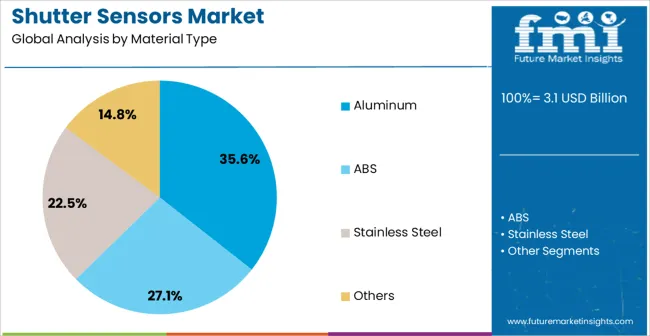
The aluminum material type segment is projected to hold 35.6% of the Shutter Sensors market revenue in 2025, positioning it as the leading material category. Growth in this segment is being driven by aluminum’s lightweight, corrosion-resistant, and thermally stable properties, which make it ideal for manufacturing durable and high-performance sensors. Aluminum enables precise fabrication of sensor components, contributing to consistent performance and extended operational life.
Its compatibility with automated production processes allows for cost-efficient manufacturing and scalability. The increasing adoption of aluminum-based sensors in industrial, automotive, and consumer applications highlights its reliability and robustness in harsh operating environments.
Additionally, aluminum’s conductive properties enhance sensor responsiveness and accuracy, supporting high-precision motion detection and imaging applications As manufacturers prioritize lightweight, efficient, and durable materials for sensor design, the aluminum segment is expected to maintain its leading position, driven by technological innovation, operational efficiency, and widespread adoption across key industries.
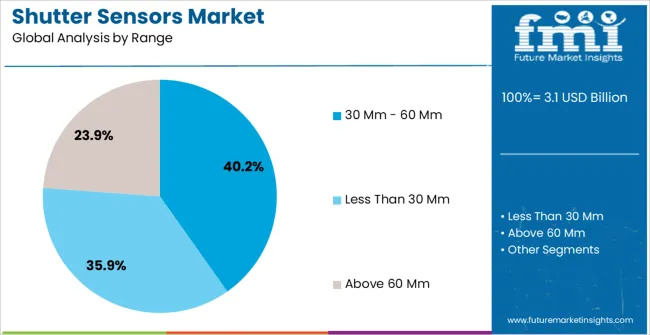
The 30 Mm - 60 Mm range segment is expected to account for 40.2% of the market revenue in 2025, establishing it as the leading range category. Its prominence is being driven by the optimal balance it provides between spatial coverage and precision, making it suitable for diverse industrial, automotive, and imaging applications.
Sensors in this range enable accurate motion detection, positioning, and object tracking while maintaining compact form factors, which is critical for space-constrained environments. Advances in manufacturing and calibration techniques have improved the consistency, reliability, and sensitivity of sensors within this range.
The growing demand for automated processes, robotics, and intelligent systems has further reinforced adoption, as the 30 Mm - 60 Mm range supports high-performance operation without sacrificing installation flexibility As industrial automation, smart factories, and advanced imaging technologies continue to expand globally, sensors within this range are expected to remain the preferred choice, supporting enhanced operational efficiency and precision across applications.
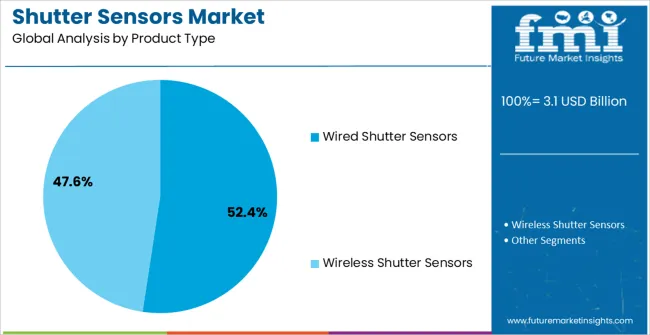
The wired shutter sensors segment is projected to hold 52.4% of the market revenue in 2025, establishing it as the leading product type. Growth in this segment is driven by its reliable data transmission, high signal stability, and consistent performance, which are critical for industrial automation, robotics, and precision imaging systems. Wired sensors offer immunity from interference and latency issues commonly associated with wireless alternatives, making them suitable for high-accuracy applications.
The ability to integrate seamlessly with control systems, PLCs, and automated equipment enhances operational efficiency and reduces maintenance requirements. Additionally, wired shutter sensors support longer operational life and are capable of operating in challenging environments with minimal signal degradation.
Adoption is further supported by established manufacturing practices and compatibility with existing infrastructure, enabling scalable deployment As industries continue to demand robust, high-performance sensing solutions, wired shutter sensors are expected to maintain their market leadership, supported by reliability, precision, and integration capabilities.
Shutter sensors are simple magnetic contact sensors that monitor the roller shutter when connected with an alarm system. Self-calibrating algorithm for professional reliability, advance microprocessor design for minimizing overall sensor size, and rugged metallic encasing for harsh use are some of the features owing to which the market of shutter sensors is expected to gain traction during the forecast period.
Furthermore, wireless shutter sensors as a result of technology advancement provide better quality and reliability, with its easy installation comes as an accessory for the GSM-based Burglar alarm system. Shifting focus of manufacturers for designing shutter sensors with compact design and enabling long-distance transmission are some of the other driving factors responsible for the growth of the shutter sensors market.
Aluminum and Acrylonitrile Butadiene Styrene (ABS) are the two major types of materials used for manufacturing shutter sensors, which improve the quality and reliability. Moreover, shutter also finds its enhanced functionality in space cameras, where the rolling shutter is presented by the image sensor, through which one can modify signaling scheme and clocking.
The only drawback of this type of shutter sensor is the decreased frame rate and increase in noise which can greatly impact the overall functionality of the shutter sensors. With the growing awareness among consumers for high security and safety, the global shutter sensors market is expected to grow at a significant rate during the forecast period.
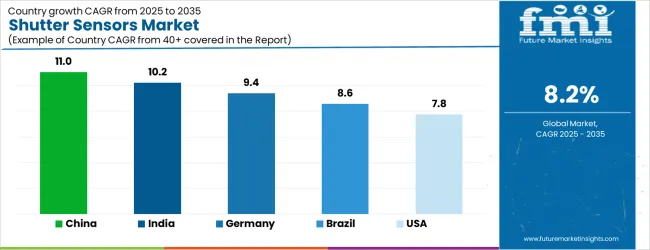
| Country | CAGR |
|---|---|
| China | 11.0% |
| India | 10.2% |
| Germany | 9.4% |
| Brazil | 8.6% |
| USA | 7.8% |
| UK | 7.0% |
| Japan | 6.1% |
The Shutter Sensors Market is expected to register a CAGR of 8.2% during the forecast period, exhibiting varied country level momentum. China leads with the highest CAGR of 11.0%, followed by India at 10.2%. Developed markets such as Germany, France, and the UK continue to expand steadily, while the USA is likely to grow at consistent rates. Japan posts the lowest CAGR at 6.1%, yet still underscores a broadly positive trajectory for the global Shutter Sensors Market. In 2024, Germany held a dominant revenue in the Western Europe market and is expected to grow with a CAGR of 9.4%. The USA Shutter Sensors Market is estimated to be valued at USD 1.1 billion in 2025 and is anticipated to reach a valuation of USD 1.1 billion by 2035. Sales are projected to rise at a CAGR of 0.0% over the forecast period between 2025 and 2035. While Japan and South Korea markets are estimated to be valued at USD 151.7 million and USD 85.6 million respectively in 2025.
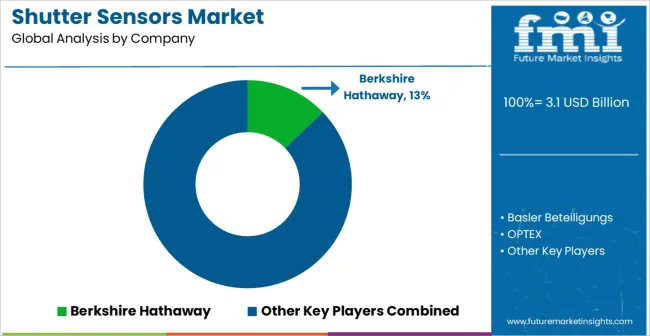
| Item | Value |
|---|---|
| Quantitative Units | USD 3.1 Billion |
| Material Type | Aluminum, ABS, Stainless Steel, and Others |
| Range | 30 Mm - 60 Mm, Less Than 30 Mm, and Above 60 Mm |
| Product Type | Wired Shutter Sensors and Wireless Shutter Sensors |
| Application | Residential, Commercial, and Industrial |
| Regions Covered | North America, Europe, Asia-Pacific, Latin America, Middle East & Africa |
| Country Covered | United States, Canada, Germany, France, United Kingdom, China, Japan, India, Brazil, South Africa |
| Key Companies Profiled | Berkshire Hathaway, Basler Beteiligungs, OPTEX, MANGAL SECURITY PRODUCTS, New Imaging Technologies, STEMMER IMAGING, MACNICA FUJI ELECTRONICS HOLDINGS, PARASNATH ELECTRONICS, Sensor Technologies America, NS Electrosecure, Quad Secure, Onebee Technology, XIMEA, Safety Star, and SI Holding |
The global shutter sensors market is estimated to be valued at USD 3.1 billion in 2025.
The market size for the shutter sensors market is projected to reach USD 6.8 billion by 2035.
The shutter sensors market is expected to grow at a 8.2% CAGR between 2025 and 2035.
The key product types in shutter sensors market are aluminum, abs, stainless steel and others.
In terms of range, 30 mm - 60 mm segment to command 40.2% share in the shutter sensors market in 2025.






Our Research Products

The "Full Research Suite" delivers actionable market intel, deep dives on markets or technologies, so clients act faster, cut risk, and unlock growth.

The Leaderboard benchmarks and ranks top vendors, classifying them as Established Leaders, Leading Challengers, or Disruptors & Challengers.

Locates where complements amplify value and substitutes erode it, forecasting net impact by horizon

We deliver granular, decision-grade intel: market sizing, 5-year forecasts, pricing, adoption, usage, revenue, and operational KPIs—plus competitor tracking, regulation, and value chains—across 60 countries broadly.

Spot the shifts before they hit your P&L. We track inflection points, adoption curves, pricing moves, and ecosystem plays to show where demand is heading, why it is changing, and what to do next across high-growth markets and disruptive tech

Real-time reads of user behavior. We track shifting priorities, perceptions of today’s and next-gen services, and provider experience, then pace how fast tech moves from trial to adoption, blending buyer, consumer, and channel inputs with social signals (#WhySwitch, #UX).

Partner with our analyst team to build a custom report designed around your business priorities. From analysing market trends to assessing competitors or crafting bespoke datasets, we tailor insights to your needs.
Supplier Intelligence
Discovery & Profiling
Capacity & Footprint
Performance & Risk
Compliance & Governance
Commercial Readiness
Who Supplies Whom
Scorecards & Shortlists
Playbooks & Docs
Category Intelligence
Definition & Scope
Demand & Use Cases
Cost Drivers
Market Structure
Supply Chain Map
Trade & Policy
Operating Norms
Deliverables
Buyer Intelligence
Account Basics
Spend & Scope
Procurement Model
Vendor Requirements
Terms & Policies
Entry Strategy
Pain Points & Triggers
Outputs
Pricing Analysis
Benchmarks
Trends
Should-Cost
Indexation
Landed Cost
Commercial Terms
Deliverables
Brand Analysis
Positioning & Value Prop
Share & Presence
Customer Evidence
Go-to-Market
Digital & Reputation
Compliance & Trust
KPIs & Gaps
Outputs
Full Research Suite comprises of:
Market outlook & trends analysis
Interviews & case studies
Strategic recommendations
Vendor profiles & capabilities analysis
5-year forecasts
8 regions and 60+ country-level data splits
Market segment data splits
12 months of continuous data updates
DELIVERED AS:
PDF EXCEL ONLINE
Sensors Market Analysis by Type, Technology, End User & Region - Forecast from 2025 to 2035
Biosensors Market Trends – Growth & Future Outlook 2025 to 2035
UV Sensors Market Analysis by Type, End User, and Region from 2025 to 2035
Nanosensors Market Size and Share Forecast Outlook 2025 to 2035
VOC Sensors and Monitors Market Analysis - Size, Growth, and Forecast 2025 to 2035
Rain Sensors Market Size and Share Forecast Outlook 2025 to 2035
Skin Sensors Market Size, Growth, and Forecast for 2025 to 2035
Weft Sensors Market - Size, Share, and Forecast Outlook 2025 to 2035
ADAS Sensors Market Growth - Trends & Forecast 2025 to 2035
PM2.5 Sensors for Home Appliances Market Size and Share Forecast Outlook 2025 to 2035
Image Sensors Market Growth – Trends & Forecast through 2034
Chest Sensors Market
PPG Biosensors Market – Size, Share & Growth Forecast 2025 to 2035
Motion Sensors Market
EMG Biosensors Market
Airbag Sensors Market
LC Dust Shutter Adapters Market Size and Share Forecast Outlook 2025 to 2035
Printed Sensors Market Size and Share Forecast Outlook 2025 to 2035
Quantum Sensors Market Size and Share Forecast Outlook 2025 to 2035
Seismic Sensors Market Size and Share Forecast Outlook 2025 to 2035

Thank you!
You will receive an email from our Business Development Manager. Please be sure to check your SPAM/JUNK folder too.
Chat With
MaRIA